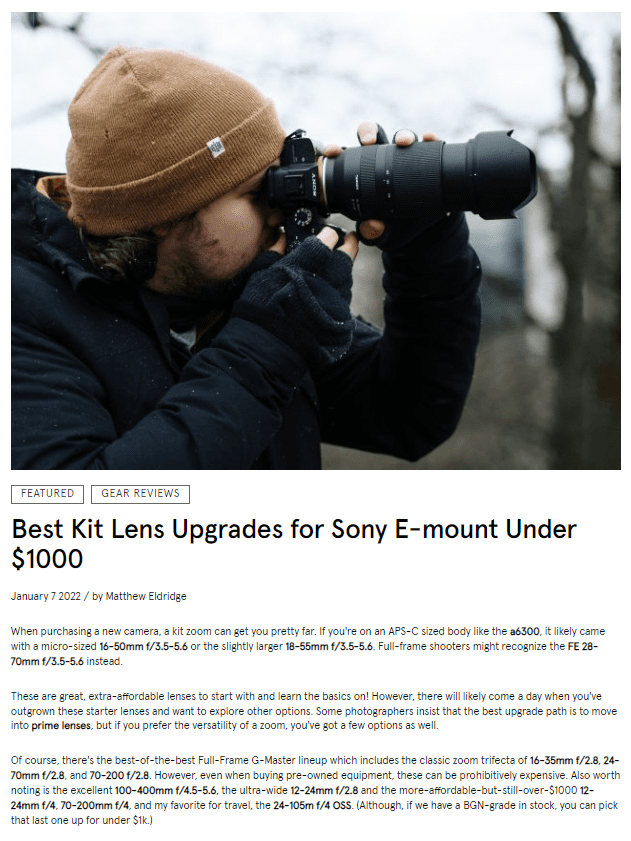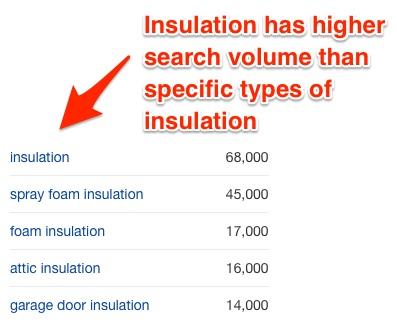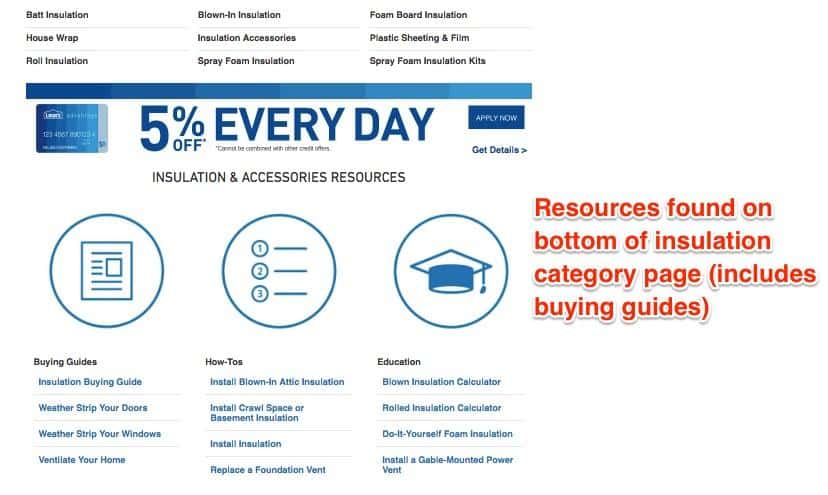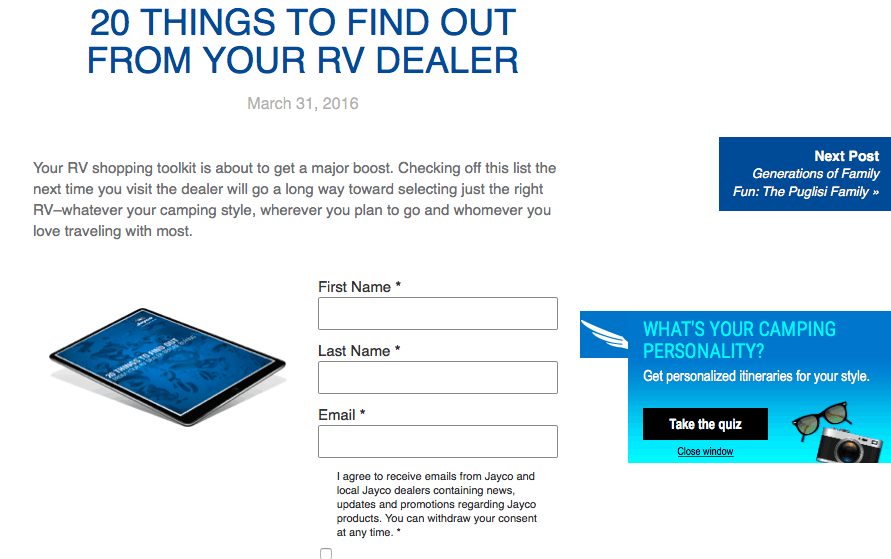Editor’s note: This case study was originally published in 2018. It has been updated for accuracy and to reflect modern practices.
Customer buyer’s guides are a must-have for our eCommerce clients, especially those who sell big purchase items or items with a more intense research process.
When there are a lot of options available or your customers have a lot of questions about a product, a buyer’s guide can answer commonly asked questions and offer product recommendations.

They’re just as beneficial for the retailers that make them. Not only do they increase organic search engine rankings and traffic, but they can also be crucial aids in customer conversions — as long as you do them right.
Here at Inflow, we’ve created buying guides for dozens of eCommerce brands, including one guide for a home improvement brand that raked in more than $100,000 in sales.
Today, we’ll share our proven process to help you create and promote a successful buying guide for your own site, too.
Note: If you’re interested in creating a buyer’s guide for some of your big-ticket items, we can help. Contact us now to get started.
How to Make a Product Guide: The Inflow Method
Below, we’ve outlined our trusted process for creating eCommerce buyer’s guides that drive organic traffic and convert interested shoppers.
Follow these steps to build your own buying guide strategy for your online business.
1. We set the topic based on search volume.
We rely heavily on organic search to promote our client’s buyer’s guides, so we don’t want to create a guide for a product that no one is searching for.
Even if you happen to sell a lot of a specific product, it doesn’t guarantee that lots of people are searching for it online.
For instance, let’s use a company that sells insulation for houses. Even if they sold more spray foam insulation than any other option, they may still want to create a more generic “home insulation buyer’s guide” because the generic term has a much higher search volume than a specific kind of insulation.

With higher search volumes, your guide is more likely to be found — and, with a more general topic, it will appeal to a wider audience. (You can always strongly recommend your top-selling product within the guide itself.)
On the other hand, creating a category-wide guide isn’t always the best practice.
Sometimes a specific product will have high search volume, in which case it makes sense to create a buyer’s guide around it. This is especially true if the product is complicated and has a longer research process.
For instance, fiber cement siding has six times the search volume of exterior siding, making it worthwhile to write that specific guide.

Learn more about choosing the best keywords for your content in our advanced keyword research guide.
2. We present all options in the guide.
Once we decide on the keywords to target (and, thus, the topic of our guide), it’s time to start writing.
Remember: The goal of this buyer’s guide isn’t to promote your products but to educate your customers during their buying journey. Therefore, you want the guide to be as inclusive as possible, even including products you may not sell. This will help build trust in your brand and increase your reputation as an authority in your market.
If a consumer is trying to decide between two types of insulation, and one of them isn’t included in the guide, it can stick out. That consumer will be less inclined to trust the guide (and your brand) when they’re ready to make a purchase.
If you don’t carry what a customer is looking for, your guide can also explain why another product may be better — but it’s still important to provide all options within the guide so the user knows that you’re giving them the full story.
3. We link to the buyer’s guide at the bottom of category pages.
After we’ve produced the guide and published it on our client’s site, we link to it in places where site visitors would be most likely to want additional product information, such as at the bottom of related category pages.

If a potential customer reaches the end of a category page and hasn’t found what they were looking for, a buyer’s guide can help keep them on the site and provide useful information to unsure consumers.
Going back to our example: Perhaps a consumer gets to the end of the insulation category page because they were overwhelmed with options. They can click into our guide to learn more about the advantages and disadvantages of blow-in versus roll insulation to aid in their buying decision.
4. We add internal links where relevant.
Our content team doesn’t stop once the buyer’s guide is created. To promote it throughout our site (and aid in our internal linking efforts), we write related blog posts that link to the buyer’s guide — and link to the posts in the guide itself.
It’s important that each piece of content offers unique information. It can’t just be a repeat of what you find in the guide or vice versa.
If you explain the advantages and disadvantages of different kinds of insulation in the guide, you could complement that information with blog posts that cover:
- What you need to know about blow-in insulation (a much deeper look into blow-in insulation than is given in the guide)
- What you need to know about your energy bill
- Whether it’s a good idea to insulate your floors
Having multiple pieces of unique but related content helps with your SEO reach, as well as provides an ecosystem of value to your customers.
5. We (sometimes) gate buyer’s guides with longer research periods.
The decision to publish a guide directly on a site or gate it behind a form depends on the goals of the client and the potential for that specific topic.
Most often, we recommend publishing the guide directly on the site. A thorough buyer’s guide is a great linkable asset and can be a great option to help with link-building efforts.
However, there are still some cases where it may make sense to put a guide behind a form.

For products with much longer research processes, being able to send follow-up emails can be greatly beneficial (more on that below). When we’ve chosen to gate a guide, we’ve seen both the buyer’s guide and follow-up emails lead to sales.
If you choose to offer your guide as a download, your landing page is crucial.
Getting email addresses from customers is crucial in the age of first-party data, but customers need to know the guide is worth it before they hand over their personal information. A landing page should offer an overview of the guide, the benefits of reading it, and highlights what they’ll find.
And, because the majority of the guide isn’t found on your site, the landing page also needs to be optimized for SEO, including relevant keywords that people would search for to find the guide.
6. In follow-up emails, we focus on helpful buying advice first — and then products.
For gated guides that we deliver via email, we commonly send 3–6 follow-up emails, depending on the product.
Here’s an example of an outline follow-up email flow:
- The first email includes a link to the PDF version of the buyer’s guide and an additional offer of help from the brand’s product experts. While this email tends not to lead to as many conversions, it has high open rates and shows users that this company cares about being helpful.
- The second email links to blog posts about the topic for further help.
- The third offers top systems the company recommends.
- The fourth email includes coupon codes.
- The fifth is a reminder that their coupons will expire after so many days.
- Lastly, depending on the typical buying cycle, we send one final email asking if the customer still needs help or if they bought a product somewhere else.
Overall, the point of emails these follow-up emails is to help consumers make a complicated buying decision.
Sure, these emails can lead to sales — but, just as importantly, they can also help grow a long-term relationship with your consumers.
Start Creating Buyer’s Guides that Build Long-term Customer Relationships
Buyer’s guides aren’t just about making a sale on one particular product. Included with follow-up emails and other educational information on your site, these guides can help your company become a trusted resource while your customers are making their buying decisions.
These guides are also an integral part of a successful eCommerce content marketing strategy based on the different stages of a buyer’s journey. The more content you can provide at every stage in the funnel, the more trust you can build with your customers — and the more likely you are to make sales.
If you’re interested in creating this type of content for your online store (or building a search engine optimization strategy incorporating other effective tactics), we can help. Request a free proposal today to learn more about how our SEO services can benefit your business goals.











0 Comments